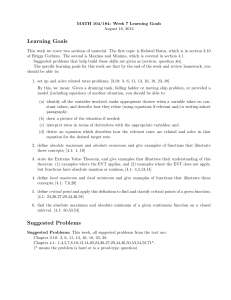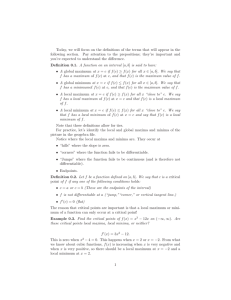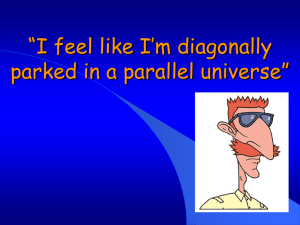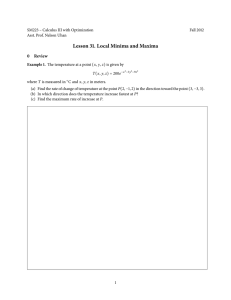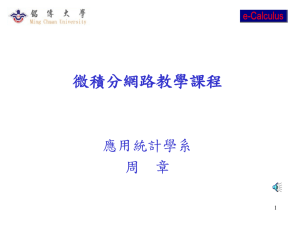Unit VI
advertisement
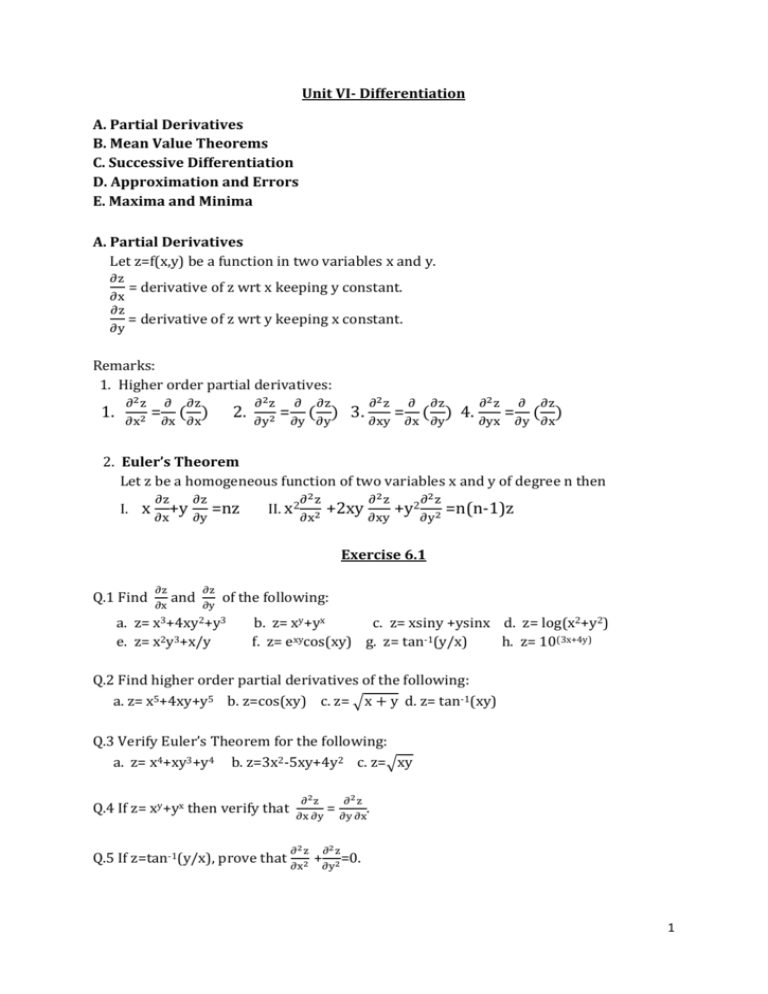
Unit VI- Differentiation A. Partial Derivatives B. Mean Value Theorems C. Successive Differentiation D. Approximation and Errors E. Maxima and Minima A. Partial Derivatives Let z=f(x,y) be a function in two variables x and y. ∂z ∂x ∂z ∂y = derivative of z wrt x keeping y constant. = derivative of z wrt y keeping x constant. Remarks: 1. Higher order partial derivatives: 1. ∂2 z ∂ ∂x ∂x ∂x ∂z = ( ) 2 2. ∂2 z ∂ ∂z ∂2 z ∂y ∂y ∂y ∂xy = 2 ( ) 3. ∂z ∂2 z ∂x ∂y ∂yx ∂ = ( ) 4. = ∂ ∂z ( ) ∂y ∂x 2. Euler’s Theorem Let z be a homogeneous function of two variables x and y of degree n then I. x ∂z +y ∂x ∂z ∂y =nz II. x2 ∂2 z ∂x2 +2xy ∂2 z ∂xy +y2 ∂2 z ∂y2 =n(n-1)z Exercise 6.1 Q.1 Find ∂z ∂x and ∂z ∂y of the following: a. z= x3+4xy2+y3 e. z= x2y3+x/y b. z= xy+yx c. z= xsiny +ysinx d. z= log(x2+y2) f. z= exycos(xy) g. z= tan-1(y/x) h. z= 10(3x+4y) Q.2 Find higher order partial derivatives of the following: a. z= x5+4xy+y5 b. z=cos(xy) c. z= √x + y d. z= tan-1(xy) Q.3 Verify Euler’s Theorem for the following: a. z= x4+xy3+y4 b. z=3x2-5xy+4y2 c. z=√xy Q.4 If z= xy+yx then verify that ∂2 z ∂2 z = . ∂x ∂y ∂y ∂x ∂2 z ∂2 z Q.5 If z=tan-1(y/x), prove that ∂x2 +∂y2 =0. 1 B. Mean Value Theorems: 1. Rolle’s Theorem If f(x) is continuous on [a,b], differentiable on (a,b) and f(a)=f(b) then there exists c∈(a,b) such that f ’(c)=0. 2. Lagrange’s Mean value theorem If f(x) is continuous on [a,b] and differentiable on (a,b) then there exists c∈(a,b) such that f ‘(c)=(f(b)-f(a))(b-a). 3. Cauchy Mean Value theorem If f(x) and g(x) are continuous on [a,b] and differentiable on (a,b) then there exist c∈(a,b) such that f(b)−f(a) g(b)−g(a) = f′ (c) g′ (c) Exercise 6.2 Q.1 Verify Rolle’s theorem for the following: (a) f(x)=x2-3x+2 for [1,2] (b) f(x)=(x-3)(x-7) for [3,7] (c) f(x)=e-xsinx for [0,π] (d) f(x)=x2-5x+7 on [0,5] Q.2 Verify Lagrange’s theorem for the following: (a) f(x)= (x-1)(x-2)(x-4) on [0,4] (b) f(x)=2x2-7x+10 on [2,5] (c) f(x)= logx on [1,e] (d) f(x)= lx2+mx+n on [a,b] Q.3 Verify CMVT. (a) f(x)=3x+2, g(x)=x2+1 on [1,4] (b) f(x)=sinx, g(x)=cosx on [0,π/2] (c) f(x)=ex, g(x)=e-x on [0,1] (d) f(x)=√x , g(x)= 1 √x on [4,9] C. Successive Differentiation Let y=f(x). n d y yn= nth order derivative of y ie f(x)= dxn = f(n)(x). 2 Sr. N. y=f(x) yn 1. c=constant 0 2. (ax+b)m npm an(ax+b)m-n if n≤m otherwise zero (−1)n n! an (ax + b)n+1 aneax 3. 1 ax + b 4. eax 5. sin(ax+b) ansin(ax+b+ 2 ) 6. cos(ax+b) ancos(ax+b+ ) 7. log(ax+b) nπ nπ 2 (−1)n−1 (n − 1)! an (ax + b)n Exercise 6.3 Find nth order derivative of the following: 1. y= x (x−1)(x−3) 2 2. y=(x−1)(x−2)(x−3) 3. y= 4. y= 4 x2 +1 x2 x+1 5. y=sin3x 6. y=cos2x 7. y= cos2x.cos5x 8. y= sinx.sin2x.sin3x 9. y=sin3x.sin5x 3 D. Approximations and Errors Let z=f(x,y) be a differentiable function. Let δx, δy, δz be amount of error (or increment) in x, y, z respectively. Then, δz= ∂z ∂x δx+ ∂z ∂y δy Percentage error: If δx is an error in x then δx x ×100 is known as percentage error in x. Exercise 6.4 Q.1 If f(x,y)=x2+y2+xy, find f(2.01,2.001) approximately. Q.2 If f(x,y)=exy, compute f(1.1,2.01) approximately, given e2=7.389. Q.3 Find percentage error in area of an ellipse of 1% error is made in measuring major and minor axes of the ellipse. l Q.4 The period of simple pendulum is T=2π√g. Find the percentage error in T due to possible errors of 1% in l and 2.5% in g. Q.5 Find the possible percentage error in computing the parallel resistance R from two resistances R1 and R2 if in both the resistances error of 2% is made. Q.6 The sides of a triangle can be measured as 12cm and 15cm and included angle is 60o. If the possible errors in the sides are 1% and in the angle is 2% then find the percentage error in determining the area. Q.7 Find the approximate value of [(0.98)2+(2.01)2]. E. Maxima/Minima Steps to find maxima/minima of f(x,y) ∂f ∂f 1. Solve ∂x =0 and ∂y =0 simultaneously. Let one of the solution be (a,b) ∂2 f ∂2 z ∂2 z 2. Let ∂x2 =r , ∂y2 =s, ∂x ∂y =t at (a,b). 3. (a,b) gives maxima if rs-t2>0 and r<0. 4. (a,b) gives minima if rs-t2>0 and r>0. 4 Exercise 6.5 Q.1 Find the extreme values of f(x,y)=x2y2(1-x-y). Q.2 Find the extreme values of xy(1-x-y). Q.3 Discuss the maxima and minima of x3+y3-9xy. Q.4 Divide 640 into three parts such that the sum of their products taken at a time is maximum. Q.5 Find maxima and minima of x3+3xy2 – 15x2-15y2+72x. 5
